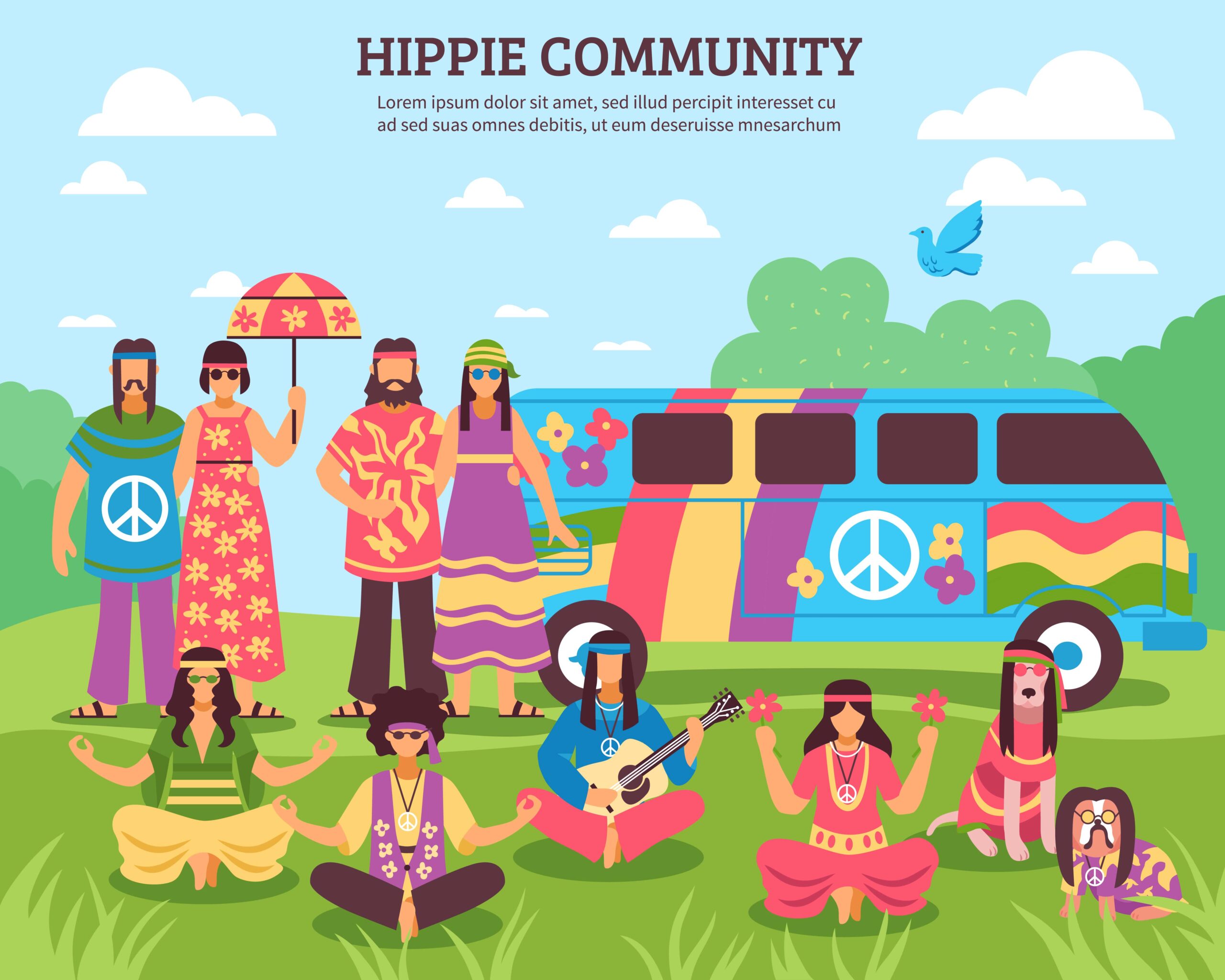A subculture is a distinct group within a larger society that shares unique values, beliefs, and practices, but still generally accepts the dominant culture. Counterculture, on the other hand, opposes and challenges the dominant cultural norms, seeking to create alternative values. And also lifestyles that go against mainstream society. Countercultures often emerge as a response to social, political, or cultural issues, while subcultures typically exist within the framework of the dominant culture without actively seeking to challenge or change it.
What is a subculture?
![]()
(Image by Rosario Zappalà from Pixabay)
Subcultures are like hidden gems within our society, carving out their own space amidst the vast ocean of mainstream culture. At their core, subcultures represent a group of individuals who share common interests, styles, and behaviors that distinguish them from the dominant cultural norms. They form tight-knit communities where members can express themselves freely without fear of judgment or rejection.
One defining characteristic of subcultures is their ability to create unique identities through fashion, music, art, and other forms of self-expression. Whether it’s the rebellious punk rockers with their leather jackets and mohawks or the free-spirited bohemians adorned in flowing garments and flower crowns – each subculture has its distinct visual language that speaks volumes about its values and beliefs.
Moreover, subcultures often emerge as a response to societal changes or as a way to challenge existing power structures. They provide an avenue for individuals to resist conformity and assert their individuality in a world that may seem homogeneous at times. Through shared experiences and ideologies, these groups foster a sense of belonging among like-minded people who yearn for connection beyond traditional social boundaries.
In addition to fostering camaraderie amongst members, subcultures also serve as incubators for creativity and innovation. The fusion of different ideas within these communities leads to the birth of new art forms, musical genres, fashion trends – pushing the boundaries of what is considered acceptable by mainstream society.
Furthermore ,subcultures can have both positive and negative effects on wider society. On one hand ,they contribute diversity ,creativity and alternative perspectives – which ultimately enriches our cultural landscape .
On another hand, some subcultural movements may perpetuate exclusivity or promote harmful ideologies that could potentially fuel social divisions .
What is a counterculture?

(Image by macrovector on Freepik)
Counterculture refers to a group or movement within a society that holds beliefs, values, and practices that are significantly different from those of the dominant culture. It is often characterized by its opposition to mainstream norms and institutions. Countercultures can emerge as a response to social, political, or cultural issues that individuals feel are not being addressed adequately.
Unlike subcultures which exist within the framework of the dominant culture, countercultures actively challenge and seek to change societal norms. They aim to create alternative ways of living and thinking that go against established traditions. Countercultural movements often advocate for social justice, equality, environmental sustainability, or other causes they perceive as important.
Examples of countercultures include the Beat Generation in the 1950s and 1960s who rejected materialism and championed artistic expression; the hippie movement in the 1960s which opposed war and embraced peace and love; or even punk subculture in the 1970s which challenged mainstream ideals through music and fashion.
Countercultures can have a profound impact on society by raising awareness about social issues, challenging oppressive systems, and pushing for change. They provide platforms for marginalized voices to be heard while encouraging individuality, creativity, and critical thinking.
By questioning established norms and promoting alternative lifestyles or ideologies countercultures offer people an opportunity to express themselves freely outside mainstream expectations. This can lead to shifts in societal attitudes over time as well as inspire new ideas or movements.
Ultimately though it’s worth noting that differentiating between subcultures vs countercultures isn’t always clear-cut since some groups may exhibit characteristics of both simultaneously depending on their specific goals or intentions towards challenging existing power structures.
Subculture Vs. Counterculture – Key differences
Subculture and counterculture may sound similar, but they have distinct differences. Subcultures are groups within a larger society that share common interests, styles, or beliefs. These subcultures often exist alongside the dominant culture but maintain their own unique identity.
On the other hand, countercultures actively reject societal norms and values. They challenge the established order and strive to create an alternative way of life that opposes mainstream ideologies.
One key difference between subcultures and countercultures lies in their relationship with the dominant culture. Subcultures coexist within society without seeking to overthrow or challenge it fundamentally. They embrace certain aspects of mainstream culture while also developing their own distinct characteristics.
In contrast, countercultures intentionally oppose and rebel against dominant cultural norms. They seek to dismantle existing structures by advocating for radical changes in social, political, or economic realms.
Another difference is evident in their impact on society. While subcultures typically influence small-scale communities or niche markets with specific interests like music genres (punk, hip-hop), fashion trends (goth, emo), or hobbies (skateboarding), countercultures tend to provoke broader social movements with more profound implications for society as a whole.
Examples of well-known subcultures include gamers who form communities around video games; food enthusiasts exploring different cuisines; or fitness fanatics engaging in various workout routines.
Countercultural movements throughout history have challenged prevailing power structures: civil rights activists fighting against racial discrimination; feminists advocating for gender equality; environmentalists raising awareness about climate change – all these demonstrate how countercultures can significantly impact societal progress.
Understanding the distinctions between subculture and counterculture helps us grasp the diverse ways individuals express themselves within a broader social context. Both phenomena contribute to shaping our world by fostering creativity, challenging conventions, and promoting individuality – each playing its part in enhancing societal diversity
Examples of subcultures
Examples of subcultures can be found in various aspects of society. One example is the punk subculture, which emerged in the 1970s as a rebellious response to mainstream culture. Punks often expressed their individuality through distinctive fashion choices such as brightly colored hair, leather jackets, and band patches. They also embraced a DIY (do-it-yourself) ethos when it came to music, creating their own bands and record labels.
Another example is the goth subculture, known for its dark aesthetic and fascination with themes like death and melancholy. Goths typically dress in black clothing adorned with symbols such as skulls or bats. They often listen to alternative music genres like gothic rock or industrial.
The hip-hop subculture originated in African-American communities in the Bronx during the 1970s and has since spread globally. It encompasses elements such as rap music, breakdancing, graffiti art, and street fashion.
Subcultures can also emerge within specific professions or hobbies. For instance, there are gaming subcultures where enthusiasts come together around shared interests in video games or tabletop role-playing games.
These examples highlight how subcultures provide individuals with a sense of belonging and identity outside of mainstream culture
Examples of countercultures
Countercultures are unique and often controversial cultural movements that challenge the dominant norms and values of society. These groups emerge as a response to societal issues or dissatisfaction with mainstream culture. Countercultures can take various forms, from political movements to artistic expressions, and they often seek to create alternative lifestyles or belief systems.
One prominent example of a counterculture is the hippie movement of the 1960s. Hippies rejected traditional societal norms, advocating for peace, love, and freedom. They embraced communal living, experimented with psychedelic drugs like LSD, and protested against war and social inequality.
Another notable countercultural movement is punk rock in the 1970s. Punk was characterized by its rebellious attitude towards authority and its DIY (do-it-yourself) ethos. It challenged mainstream music industry conventions with its aggressive sound, unconventional fashion style (spiked hair, torn clothes), and provocative lyrics.
In recent years, there has been an emergence of various online subcultures that could be considered countercultural due to their rejection of mainstream ideologies or societal expectations. For instance, the “Dark Academia” subculture celebrates intellectualism while rejecting consumerism-driven education systems prevalent today.
Countercultures have had both positive and negative impacts on society throughout history. On one hand,
they have sparked important social change revolutions by challenging oppressive systems; on another hand,
countercultures have sometimes faced backlash from conservative elements within society who perceive them
as threats to traditional values.
These examples serve as reminders that countercultures play an essential role in shaping our collective understanding of culture itself.
How subcultures and countercultures can affect society?
Subcultures and countercultures have the power to shape and transform society in various ways. These alternative groups challenge mainstream norms, values, and beliefs, often leading to significant social change.
One way subcultures impact society is by offering individuals a sense of belonging and identity. People who feel marginalized or misunderstood find solace within these communities that embrace their unique interests, hobbies, or lifestyles. For example, the punk subculture emerged as a form of rebellion against societal expectations in the 1970s. It provided a space for those who felt disillusioned with mainstream culture to express themselves freely through music, fashion, and activism.
Countercultures go even further by actively opposing dominant ideologies and institutions. They aim to dismantle existing social structures deemed oppressive or unjust. The civil rights movement in the United States during the 1960s serves as a prominent example of countercultural influence on society. Activists fought against racial segregation and discrimination, ultimately leading to legal reforms that transformed the landscape of equality.
Both subcultures and countercultures can also inspire artistic movements that challenge conventional norms within creative fields such as art, literature, music, film-making, etc. By pushing boundaries and exploring new ideas outside traditional frameworks,
these alternative groups contribute to cultural innovation.
However, subcultures and countercultures are not without critics. Some argue that they can create divisions within society, promote exclusivity, or lead to alienation from mainstream culture. It’s important to recognize that while these alternative groups have the potential to affect positive change, they must do so without disregarding fundamental human rights or fostering harmful ideologies.
What are two types of subculture?
Subcultures are fascinating and diverse, with various types existing within society. Let’s explore two interesting types of subcultures that have their own distinct characteristics.
1. Music Subculture: This type of subculture revolves around a particular genre or style of music. From punk rockers to hip-hop enthusiasts, these groups form tight-knit communities centered around their shared love for specific sounds. They often develop unique fashion styles, slang terms, and even rituals related to the music they listen to. These subcultures can be found in every corner of the world, providing a sense of identity and belonging for those who feel connected through the power of rhythm and melody.
2. Gaming Subculture: In recent years, gaming has become more than just a hobby; it has evolved into a thriving subculture encompassing both casual gamers and dedicated enthusiasts alike. Gamers bond over their favorite games, consoles, or platforms and engage in discussions about strategy tips or game lore online or at conventions like E3 (Electronic Entertainment Expo). This digital realm has its own language filled with acronyms like “GG” (good game) or “OP” (overpowered), creating an exclusive environment where gamers can connect on a deeper level.
These two examples barely scratch the surface when it comes to exploring different types of subcultures that exist today. Each one offers unique experiences and opportunities for individuals seeking camaraderie based on shared interests outside mainstream culture.
Featured Image By – Kevin Schmid on Unsplash








